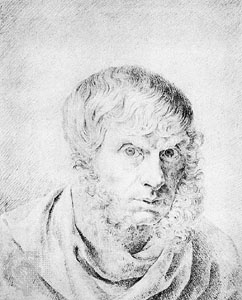Friedrich, Caspar David
German painter
born Sept. 5, 1774, Greifswald, Pomerania 【Germany】
died May 7, 1840, Dresden, Saxony
 pioneer early 19th-century German Romantic painter. His vast, mysterious landscapes and seascapes proclaimed man's helplessness against the forces of nature and did much to establish the idea of the sublime as central concerns of the Romantic movement.
pioneer early 19th-century German Romantic painter. His vast, mysterious landscapes and seascapes proclaimed man's helplessness against the forces of nature and did much to establish the idea of the sublime as central concerns of the Romantic movement.Friedrich studied from 1794 to 1798 at the academy at Copenhagen but was largely self-taught. Settling at Dresden, he became a member of an artistic and literary circle that included the painter Philipp Otto Runge and the writers Ludwig Tieck and Novalis. His drawings in sepia, executed in his neat early style, won the poet J.W. von Goethe's approval and a prize from the Weimar Art Society in 1805. His first important oil painting, “The Cross in the Mountains” (c. 1807), established his mature style, characterized by an overwhelming sense of isolation, and was an attempt to replace the traditional symbology of religious painting with one drawn from nature. Other symbolic landscapes, such as “Shipwreck in the Ice” (1822), reveal his fatalism and obsession with death. Though based on close observation of nature, his works were coloured by his imaginative response to the atmosphere of the Baltic coast and the Harz Mountains, which he found both awesome and ominous. In 1824 he was made professor of the Dresden academy. For a long time his work was forgotten; but it was revived when the 20th century recognized its own existential isolation in his work.
- fatty acid
- Fatḥ ʿAlī Shāh
- faujasite
- Faulhaber, Michael von
- Faulkner, William
- fault
- Fauna
- faunal region
- faunal succession, law of
- faunizone
- Faunus
- Faure, Edgar
- Faure, Félix
- Fauresmith industry
- Fauriel, Claude
- Fauré, Gabriel
- Fauset, Jessie Redmon
- Faust
- Faust, Drew Gilpin
- Faustina, Annia Galeria
- Faustina Bordoni
- Faustin-Élie Soulouque
- Fausto Duarte
- Fausto Elhuyar
- Faustus of Riez, Saint